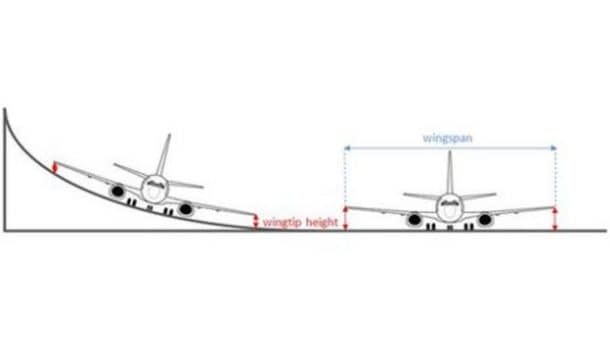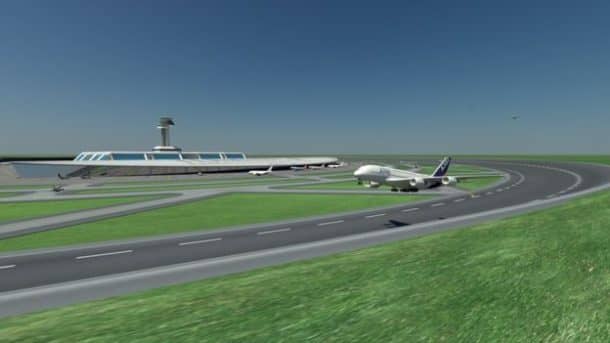Remember the circular runway concept we covered two weeks back? The idea is to reduce the low space and traffic congestion issues by changing the conventional runway into a circular one. As revolutionary as it sounds, there were also many skeptics to the idea as well. BBC took many of the questions and apprehensions about the idea and asked the Dutch engineer and designer of the concept himself, Henk Hesselink.
Wing crashing: Will the wings hit the tarmac?

Henk Hesseklink:
With the banked character of the runway, the wingtips and engines are closer to the ground than currently is the case.
But the bank angle is designed such that even the most constrained aircraft (Boeing 747 and Airbus A380) will be able to land.
Still, there is less margin for error than is currently the case. Pilots will need automated support for take-off and landing.
Henk also drew this diagram:

Rejected take-offs: Some were concerned about takeoffs that were rejected.

Henk responds:
As there is no end to the runway, a starting aircraft can keep rolling and come to a stop in a safer way than is currently the case.
We will need a safety distance between individual aircraft, which we took into consideration in our trials.

We used a runway length of three kilometres for planning purposes and a safety distance between separate aircraft of one kilometre.
Can ILS (Instrument Landing System), a system that helps pilots land using precision guidance, cope with a circular approach?

Henk Hesselink:
Obviously, as we are making a turn during the landing, the ILS (Instrument Landing System) will not function. But we may be able to use an ILS-system for part of the approach phase, the first part is still straight-in.
Either we put a simple form of ILS on each direction of the runway, or we can install a movable ILS-system that will move around the runway, for example on a rail-track . It is a bit far-fetched, I know.

Better would be to use some new approach, like satellite navigation. The current quality of GPS is not sufficient, but new methods are already being investigated.
I think developments in this area will move very fast as there is more demand for accurate location information, from trains, cars, drones, etc. Already curved approaches and fixed curves are used in aviation, requiring new navigation systems.
Ice, rain and ‘go arounds’
Aviation enthusiast Phil Derner pointed out two major flaws with the idea in Business Insider magazine. He argues that sleet, ice, and rain will reduce the friction, thus reducing the centrifugal force on the circular runways and increasing the stopping distance.
He added:
“What if three airliners are landing, something goes wrong and they abort landings. Their prescribed go-around procedure would likely take them dangerously close to the other aircraft.”
Henk responds:
Indeed, like on a “normal” runway, ice and rain will have an effect on the operation. It is a fact that nowadays runway surfaces are getting better and are becoming more resistant to difficult conditions, and the current concrete absorbs most of the water.
We have been thinking about building offices and parking spaces under the runway and the remaining heat could be transferred to the runway, but this is an idea that will need further exploration. Heating of the runway surface is something that is already being applied.

A new system for planning how aircraft move to and from the runway will be necessary.
We have designed a system where the air traffic controller is supported by a ‘circular’ planning tool. This seems strange at first, but is already applied in other fields. The planning will take all safety aspects into account, such as the possibility for a go-around by one or more aircraft simultaneously.
What about the stalling speeds while the aircraft is banking?

Henk replies:
A higher speed will be necessary, indeed.
Take-off and landing run will increase because of this and the time that an aircraft spends on the runway will be about five to ten seconds longer.
Would the airplane fall off the runway during an emergency landing?
Henk:
The width of the runway has been extended by another 20 meters for safety. We consider safety a major issue and made calculations on the necessary runway dimensions.
Anyway, the “edge” of the runway should not be designed as a large wall that airplanes can fall down from.
This additional safety distance is also necessary when the airplane lands at a point of the runway where it will be too low and the centrifugal forces will move it to the outside of the track and further outside than its optimal track.
We have calculated that the additional 20 meters will suffice for the safety case. We have also calculated that the aircraft will move to its optimal track in just one or two iterations, so no continuous bouncing upwards and downwards will occur. This is confirmed by the tests from the 1960s.


